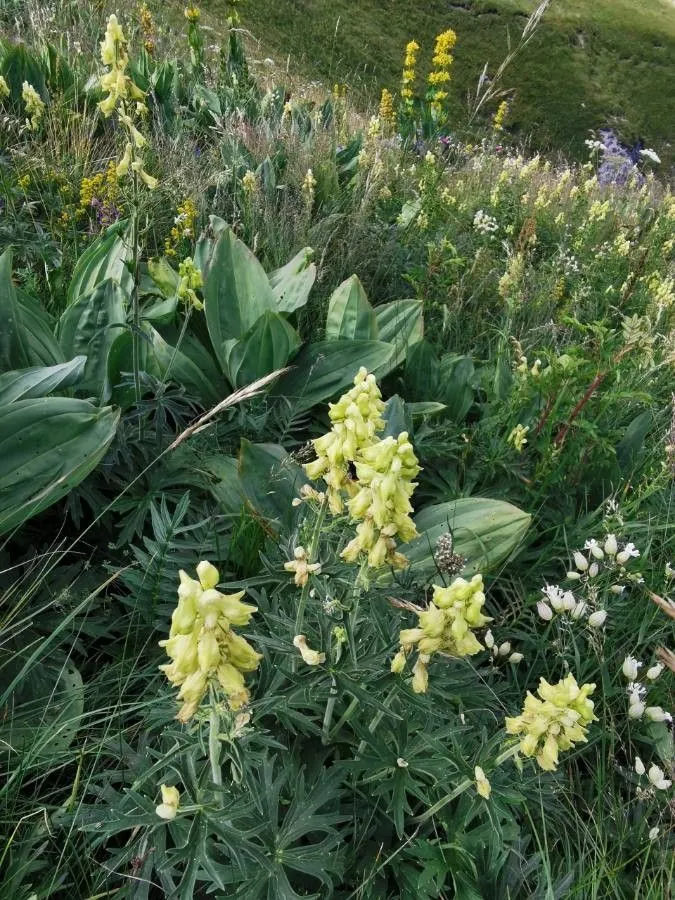
Author: L.
Bibliography: Sp. Pl.: 532 (1753)
Year: 1753
Status: accepted
Rank: species
Genus: Aconitum
Vegetable: False
Observations: C. & E. Europe
Wolf’s-bane, scientifically known as Aconitum lycoctonum, is a fascinating and historically significant plant primarily found across Central and Eastern Europe. It belongs to the Ranunculaceae family, a group that includes many well-known flowering plants.
This plant’s allure is rooted not only in its striking appearance but also in its notorious reputation due to its toxic properties. Traditionally, Aconitum lycoctonum has been surrounded by both awe and caution due to its potent alkaloids that make it a species to be admired from a safe distance. The common name “Wolf’s-bane” stems from its historic use as a poison for hunting wolves, emphasizing its potent effects.
Wolf’s-bane thrives in cool mountainous regions where it can often be found decorating the landscape with its vibrant flowers. The plant typically showcases a spectrum of enchanting purple to blue blooms that rise elegantly from its slender stems, creating a picturesque contrast against the greenery of its leaves.
The detailed study of Aconitum lycoctonum, by the botanical authority Carl Linnaeus, was first documented in 1753, in his seminal work “Species Plantarum”. Linnaeus’ classification laid the groundwork for future botanical studies and highlighted the plant’s unique characteristics.
While its beauty is undeniable, this plant is also a symbol of respect for nature’s potency and the early botanical exploration that unveiled its secrets. Thus, Wolf’s-bane remains a crucial subject of interest for botanists and plant enthusiasts alike, marking an intersection between natural splendor and potent bioactivity within the ecological tapestry of Europe.
Deu: gelber eisenhut i.w.s.
Dan: ulve-stormhat
Swe: alpstormhatt, keltaukonhattu, vargstormhatt
Fin: keltaukonhattu
Nob: tyrihjelm
Nno: tyrihjelm
Eng: wolf’s-bane, wolfsbane monkshood, alpine wolfsbane, badger’s bane
Fra: aconit tue-loup, aconit étrangle-loup, herbe au loup
Cym: cwcwll-y-mynach melyn
En: Wolf’s-bane, Wolfsbane monkshood, Alpine wolfsbane, Badger’s bane, Monkshood
Ar: أكونيت قاتل
Az: Qurdboğan kəpənəkçiçək
Be: Боцікі звычайныя
Bg: Северна самакитка
Zh: 狼毒乌头
Hr: Oštrobridi jedić
Cs: Oměj vlčí mor
Da: Ulve-stormhat
Et: Kollane käoking
Fi: Keltaukonhattu, Hukanukonhattu
Fr: Aconit tue-loup, Aconit étrangle-loup, Herbe au loup
De: Fuchs-Eisenhut, Gelber Eisenhut, Wolfs-Eisenhut, Gelber Eisenhut i.w.S.
Kk: Bärpi, Бәрпі, ٴبارپى
Nb: Tyrihjelm
Nn: Tyrihjelm
Pl: Tojad lisi
Ru: Борец северный
Sk: Prilbica žltá
Sv: Alpstormhatt, Keltaukonhattu, Vargstormhatt
Tt: Биек аю көпшәсе
Uk: Тоя вовкобійна
Cy: Cwcwll-y-mynach melyn
© copyright of the Board of Trustees of the Royal Botanic Gardens, Kew.
© copyright of the Board of Trustees of the Royal Botanic Gardens, Kew.
© copyright of the Board of Trustees of the Royal Botanic Gardens, Kew.
Taken Aug 9, 2021 by Laure Dumaître (cc-by-sa)
Taken Aug 12, 2021 by Jacques Zuber (cc-by-sa)
Taken Jul 10, 2018 by Sylvain Delépine (cc-by-sa)
Taken Jul 14, 2019 by mar mar k (cc-by-sa)
Taken Aug 23, 2018 by Tom Coleman (cc-by-sa)
Taken Aug 13, 2020 by ipodobin (cc-by-sa)
Taken Aug 9, 2021 by Jean-François (cc-by-sa)
Taken Aug 12, 2021 by Jacques Zuber (cc-by-sa)
Taken Aug 9, 2021 by Frozy
Taken Aug 12, 2021 by Josette Guilpain (cc-by-sa)
Taken Aug 7, 2021 by Sergio costantini (cc-by-sa)
Taken Jul 11, 2021 by Alain Bigou (cc-by-sa)
Taken Jul 28, 2020 by Gilles Luciani (cc-by-sa)
Taken Aug 12, 2021 by Jacques Zuber (cc-by-sa)
Taken Aug 9, 2021 by Frozy
Taken Aug 4, 2022 by Vladimír Valach (cc-by-sa)
Taken Aug 16, 2021 by Kees Verhoek (cc-by-sa)
Taken Aug 29, 2017 by Tela Botanica − Florent BECK (cc-by-sa)
Taken Aug 21, 2021 by Bernard Haute Savoie (cc-by-sa)
Taken Aug 9, 2021 by Frozy
Taken Jul 10, 2020 by Jean-Luc Durand (cc-by-sa)
Taken May 27, 2018 by Maurice Maeck (cc-by-sa)
Taken May 27, 2018 by Maurice Maeck (cc-by-sa)
Taken Aug 23, 2019 by Michel Cosme (cc-by-sa)
Taken Jul 8, 2019 by st-p silke (cc-by-sa)
Taken Jun 15, 2020 by Dieter Albrecht (cc-by-sa)
Taken Jul 18, 2019 by MICHEL DUSSERE (cc-by-sa)
Taken Mar 28, 2021 by André Helfer (cc-by-sa)
Taken May 29, 2020 by Ghis Berland (cc-by-sa)
Taken Sep 28, 2020 by Philip (cc-by-sa)
Growth habit: Forb/herb
Ph maximum: 7.5
Ph minimum: 7.0
Light: 5
Atmospheric humidity: 8
Soil nutriments: 7
Family: Myrtaceae Author: (F.Muell.) K.D.Hill & L.A.S.Johnson Bibliography: Telopea 6: 402 (1995) Year: 1995 Status:…
Family: Rubiaceae Author: Pierre ex A.Froehner Bibliography: Notizbl. Bot. Gart. Berlin-Dahlem 1: 237 (1897) Year:…
Family: Sapindaceae Author: Koidz. Bibliography: J. Coll. Sci. Imp. Univ. Tokyo 32(1): 38 (1911) Year:…
Family: Asteraceae Author: A.Gray Bibliography: Pacif. Railr. Rep.: 107 (1857) Year: 1857 Status: accepted Rank:…
Family: Fabaceae Author: Medik. Bibliography: Vorles. Churpfälz. Phys.-Ökon. Ges. 2: 398 (1787) Year: 1787 Status:…
Family: Aspleniaceae Author: (Cav.) Alston Bibliography: Bull. Misc. Inform. Kew 1932: 309 (1932) Year: 1932…